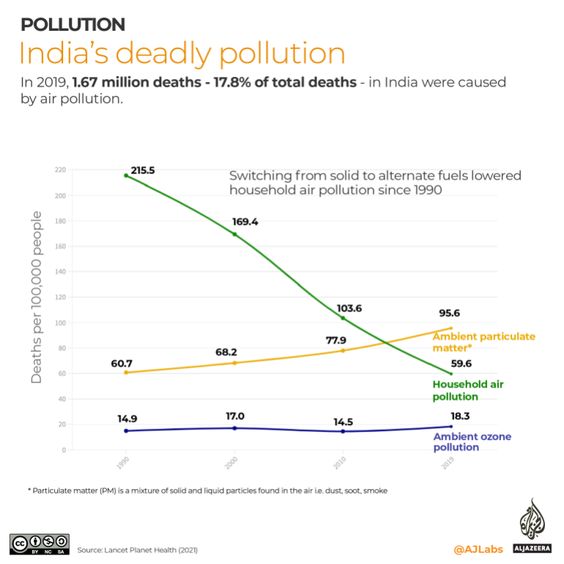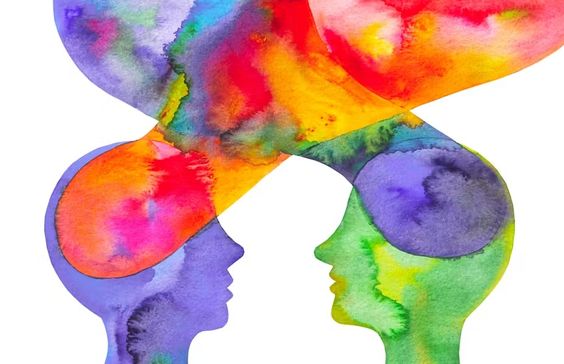Fossil fuels cause 4.5 million premature deaths each year, cost $8 billion every day, cause 40,000 deaths of children younger than 5, and result in 1.8 billion days of work lost from illnesses related to PM2.5.
Greenpeace Southeast Asia. (2020). Toxic air: The price of fossil fuels (full report)
PM2.5 : fine inhalable particles, with diameters that are generally 2.5 micrometers and smaller.
Updated December 3. 2023 (originally posted December 2. 2021)

A toxic haze has smothered Delhi since the festival of Diwali.
BBC: Authorities in the Indian capital, Delhi, have shut all schools and colleges indefinitely amid the worsening levels of air pollution.
Construction work has also been banned until 21 November but an exception has been made for transport and defense-related projects. Only five of the 11 coal-based power plants in the city have been allowed to operate.
The levels of PM2.5 – tiny particles that can clog people’s lungs – in Delhi are far higher than the World Health Organization’s (WHO) safety guidelines. Several parts of the city recorded figures close to or higher than 400 on Tuesday, which is categorized as “severe”.
Some schools had already shut last week because of pollution and the Delhi government said it was mulling over a lockdown to improve air quality as dense clouds of smog engulfed the city.
A mix of factors like vehicular and industrial emissions, dust, and weather patterns make Delhi the world’s most polluted capital. The air turns especially toxic in the winter months as farmers in neighboring states burn crop stubble. And fireworks during the festival of Diwali, which happens at the same time, only worsen the air quality. Low wind speed also plays a part as it traps the pollutants in the lower atmosphere.
How is air quality measured?
Air quality is determined by the levels of air pollutants PM2.5, PM10, ozone, nitrogen dioxide, sulfur dioxide, and carbon monoxide.
Particulate matter (PM) comprises tiny particles that negatively impact health. PMs vary in size, the most damaging are PM2.5 and PM10 – with a diameter of less than 2.5 μm and 10μm respectively. A human hair’s diameter is 50-70 μm. PM2.5 levels lower than 12 are considered good, 55-150 unhealthy and 250 or above is hazardous.

India’s deadly pollution
In 2019, 1.67 million deaths in India were caused by air pollution, according to the Lancet.
While replacing solid fuels with alternatives has lowered deaths linked to household air pollution since 1990, deaths related to ambient PMs have increased.
Fifteen of the 20 most polluted cities are in India, mostly in the north. Stubble burning spikes pollution in autumn and winter. Vehicle emissions, industry, and burning rubbish also contribute to high levels of PM2.5 and other pollutants.

Air pollution’s health impacts
According to the WHO, some 7 million people die annually as a result of air pollution. More than 90 percent of the world’s population lives in areas where air pollution exceeds WHO limits. Air pollution is linked to a number of illnesses including asthma, diabetes, and heart disease.


United Nations Global Goals for Sustainable Development
Ensuring healthy lives and promoting well-being at all ages is essential to sustainable development. Currently, the world is facing a global health crisis unlike any other — COVID-19 is spreading human suffering, destabilizing the global economy, and upending the lives of billions of people around the globe.
Before the pandemic, major progress was made in improving the health of millions of people. Significant strides were made in increasing life expectancy and reducing some of the common killers associated with child and maternal mortality. But more efforts are needed to fully eradicate a wide range of diseases and address many different persistent and emerging health issues. By focusing on providing more efficient funding of health systems, improved sanitation, and hygiene, and increased access to physicians, significant progress can be made in helping to save the lives of millions.
Health emergencies such as COVID-19 pose a global risk and have shown the critical need for preparedness. The United Nations Development Programme highlighted huge disparities in countries’ abilities to cope with and recover from the COVID-19 crisis. The pandemic provides a watershed moment for health emergency preparedness and for investment in critical 21st-century public services.
COVID-19 response
The World Health Organization (WHO) has been leading the global effort to tackle COVID-19. The Strategic Preparedness and Response Plan, produced by WHO and partners, outlines the public health measures that countries should take to prepare for and respond to COVID-19. The Strategy Update of April 2020 provides further guidance for the public health response to COVID-19 at national and sub-national levels and highlights the coordinated support that is required from the international community to meet the challenge of COVID-19.
People and organizations who want to help fight the pandemic and support WHO and partners can donate through the COVID-19 Solidarity Response Fund which supports WHO’s work to track and understand the spread of the virus, to ensure patients get the care they need and frontline workers get essential supplies and information, and to accelerate research and development of a vaccine and treatments for all who need them.
WHO, together with partners, also provides guidance and advice for people to look after their mental health during the COVID-19 pandemic — especially health workers, managers of health facilities, people who are looking after children, older adults, people in isolation, and members of the public more generally.
The pandemic is much more than a health crisis. It requires a whole-of-government and whole-of-society response, matching the resolve and sacrifice of frontline health workers.
Facts and Figures
Child health
- In 2018 an estimated 6.2 million children and adolescents under the age of 15 years died, mostly from preventable causes. Of these deaths, 5.3 million occurred in the first 5 years, with almost half of these in the first month of life.
- Despite determined global progress, an increasing proportion of child deaths are in Sub-Saharan Africa and Southern Asia. Four out of every five deaths of children under age five occur in these regions.
- Children in sub-Saharan Africa are more than 15 times more likely to die before the age of 5 than children in high income countries.
- Malnourished children, particularly those with severe acute malnutrition, have a higher risk of death from common childhood illness such as diarrhoea, pneumonia, and malaria. Nutrition-related factors contribute to about 45per cent of deaths in children under-5 years of age.
Maternal health
- Over 40 per cent of all countries have fewer than 10 medical doctors per 10,000 people; over 55 per cent of countries have fewer than 40 nursing and midwifery personnel per 10,000 people.
- In Eastern Asia, Northern Africa and Southern Asia, maternal mortality has declined by around two-thirds.
- Every day in 2017, approximately 810 women died from preventable causes related to pregnancy and childbirth.
- 94per cent of all maternal deaths occur in low and lower middle-income countries.
- Young adolescents (ages 10-14) face a higher risk of complications and death as a result of pregnancy than other women.
- But maternal mortality ratio – the proportion of mothers that do not survive childbirth compared to those who do – in developing regions is still 14 times higher than in the developed regions.
HIV/AIDS, malaria, and other diseases
- 38 million people globally were living with HIV in 2019.
- 25.4 million people were accessing antiretroviral therapy in 2019.
- 1.7 million people became newly infected with HIV in 2019.
- 690 000 people died from AIDS-related illnesses in 2019.
- 75.7 million people have become infected with HIV since the start of the epidemic.
- 32.7 million people have died from AIDS-related illnesses since the start of the epidemic.
- Tuberculosis remains the leading cause of death among people living with HIV, accounting for around one in three AIDS-related deaths.
- Globally, adolescent girls and young women face gender-based inequalities, exclusion, discrimination and violence, which put them at increased risk of acquiring HIV.
- HIV is the leading cause of death for women of reproductive age worldwide.
- AIDS is now the leading cause of death among adolescents (aged 10–19) in Africa and the second most common cause of death among adolescents globally.
- Over 6.2 million malaria deaths have been averted between 2000 and 2015, primarily of children under five years of age in sub-Saharan Africa. The global malaria incidence rate has fallen by an estimated 37 per cent and the mortality rates by 58 per cent.
Goal 3 Targets
3.1 By 2030, reduce the global maternal mortality ratio to less than 70 per 100,000 live births.
3.2 By 2030, end preventable deaths of newborns and children under 5 years of age, with all countries aiming to reduce neonatal mortality to at least as low as 12 per 1,000 live births and under-5 mortality to at least as low as 25 per 1,000 live births.
3.3 By 2030, end the epidemics of AIDS, tuberculosis, malaria, and neglected tropical diseases and combat hepatitis, water-borne diseases, and other communicable diseases.
3.4 By 2030, reduce by one-third premature mortality from non-communicable diseases through prevention and treatment and promote mental health and well-being.
3.5 Strengthen the prevention and treatment of substance abuse, including narcotic drug abuse and harmful use of alcohol.
3.6 By 2020, halve the number of global deaths and injuries from road traffic accidents.
3.7 By 2030, ensure universal access to sexual and reproductive healthcare services, including family planning, information and education, and the integration of reproductive health into national strategies and programs.
3.8 Achieve universal health coverage, including financial risk protection, access to quality essential healthcare services, and access to safe, effective, quality, and affordable essential medicines and vaccines for all.
3.9 By 2030, substantially reduce the number of deaths and illnesses from hazardous chemicals and air, water, and soil pollution and contamination.
3.A Strengthen the implementation of the World Health Organization Framework Convention on Tobacco Control in all countries, as appropriate.
3.B Support the research and development of vaccines and medicines for the communicable and non-communicable diseases that primarily affect developing countries, provide access to affordable essential medicines and vaccines, in accordance with the Doha Declaration on the TRIPS Agreement and Public Health, which affirms the right of developing countries to use to the full the provisions in the Agreement on Trade Related Aspects of Intellectual Property Rights regarding flexibilities to protect public health, and, in particular, provide access to medicines for all.
3.C Substantially increase health financing and the recruitment, development, training, and retention of the health workforce in developing countries, especially in the least developed countries and small island developing States.
3.D Strengthen the capacity of all countries, in particular developing countries, for early warning, risk reduction, and management of national and global health risks.
Links
WHO – Reducing Child Mortality
UNFPA Sexual & reproductive health






1 Comment
Pingback: winter morning jazz